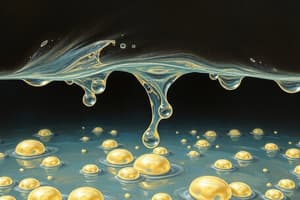Podcast
Questions and Answers
What is the characteristic of phospholipids that makes them form bilayers?
What is the characteristic of phospholipids that makes them form bilayers?
- They have two water-fearing tails (correct)
- They have one water-fearing tail
- They are amphipathic
- They are hydrophilic
What is the primary factor that governs the formation of rod-shaped micelle?
What is the primary factor that governs the formation of rod-shaped micelle?
- Concentration of monomers
- pH level
- Temperature
- Gibbs free energy (correct)
Which type of micelle is formed at higher concentration?
Which type of micelle is formed at higher concentration?
- Bilayer micelle
- Rod-shaped micelle
- Laminar micelle (correct)
- Spherical micelle
What is the arrangement of monomers in rod-shaped micelle?
What is the arrangement of monomers in rod-shaped micelle?
Which of the following molecules has only one water-fearing tail?
Which of the following molecules has only one water-fearing tail?
What is the shape of the central part of the hydrocarbon radius in rod-shaped micelle?
What is the shape of the central part of the hydrocarbon radius in rod-shaped micelle?
Which type of micelle is interconvertible with other types?
Which type of micelle is interconvertible with other types?
Study Notes
Types of Micelles
-
Spherical Micelles: amphipathic molecules can form bilayers or spherical micelles, where phospholipids (amphipathic molecules with two water-fearing tails) prefer to form bilayers, while fatty acids (with one water-fearing tail) form micelles more easily and stably.
-
Rod-Shaped Micelles: monomers are arranged in a rod shape, governed by the characteristic Gibbs free energy of rod formation, with a central cylindrical part and hemispherical parts at the ends, influenced by hydrophobic, electrostatic, and steric interactions.
-
Laminar Micelles: formed at higher concentrations, where initially spherical micelles convert to laminar micelles as the concentration increases, with monomers arranged in a laminar manner.
Studying That Suits You
Use AI to generate personalized quizzes and flashcards to suit your learning preferences.
Related Documents
Description
Learn about the different types of micelles, including spherical and rod-shaped micelles, and their formation from amphipathic molecules such as phospholipids and fatty acids.




